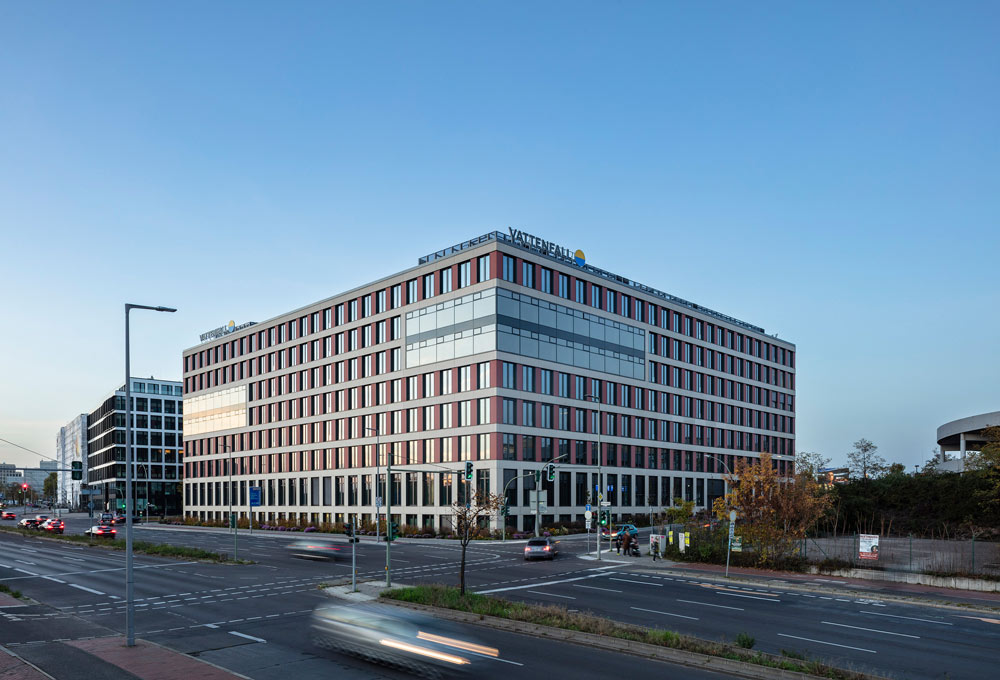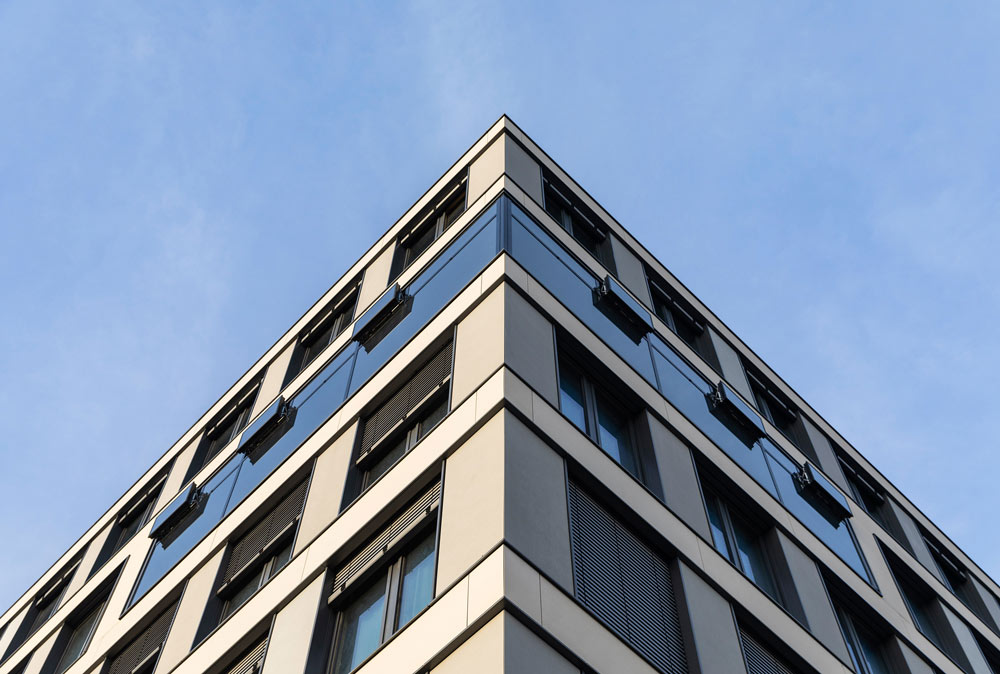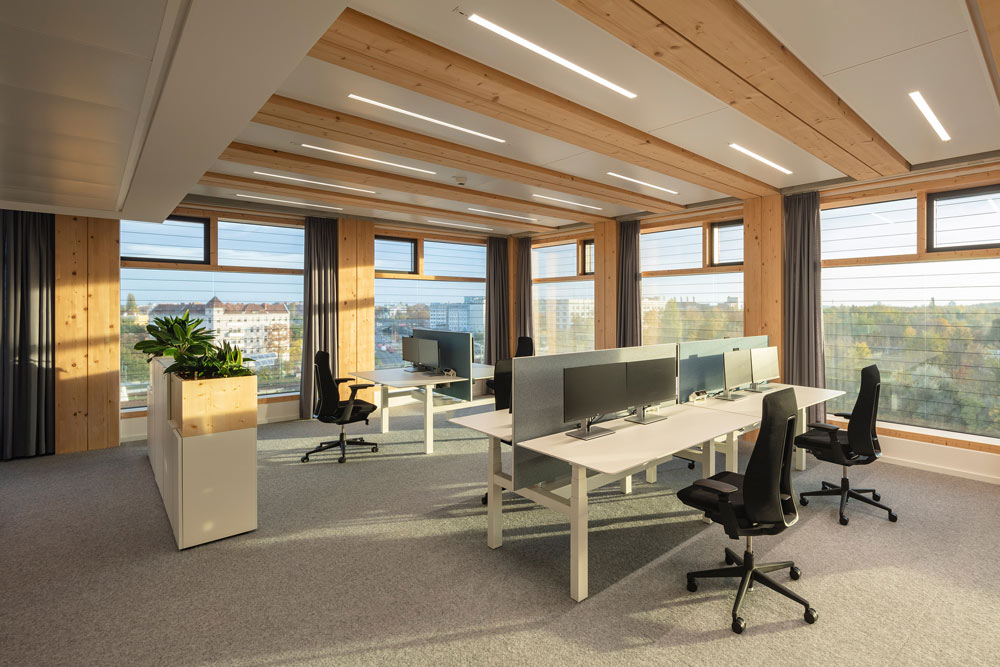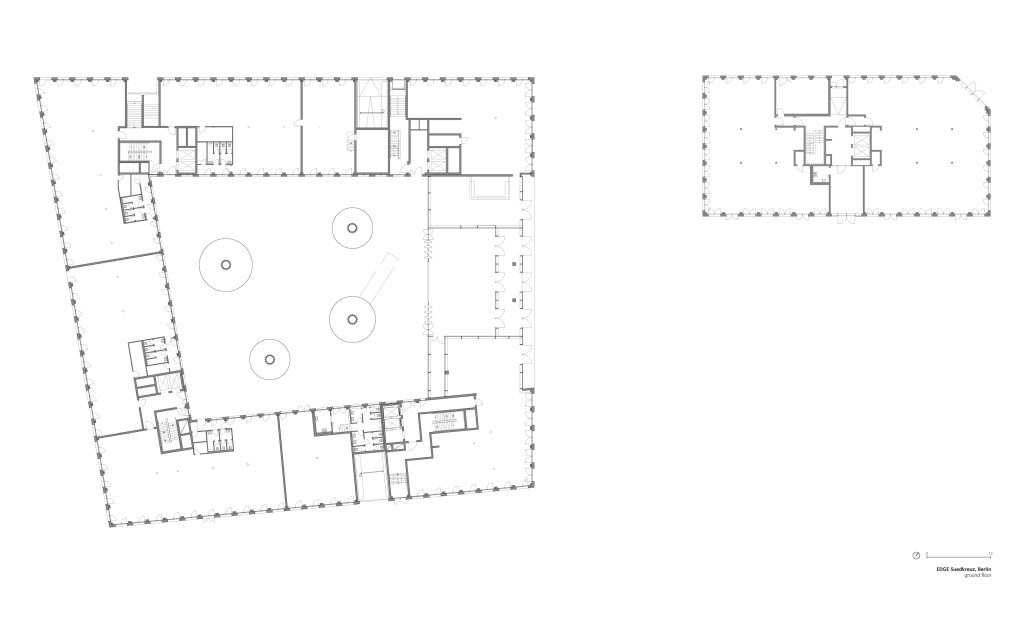EDGE Suedkreuz Berlin proposes a new concept of a sustainable future for building systems with timber. Designed by TCHOBAN VOSS Architekten, EDGE Suedkreuz Berlin is a seven-story office complex consisting of two structures with a total base area of around 32,000 sqm. The complex stands on an around 10,100 sqm area and has been built using sustainable, climate- and resource-saving, and modular hybrid-timber construction methods. The larger two freestanding structures contain around 20,000 sqm of floor area.
EDGE Suedkreuz Berlin is Germany’s biggest freestanding hybrid-timber project and one of the largest in Europe. In 2022, the German Sustainable Building Council (DGNB) designated the project as Germany’s most sustainable building. It has been the new German headquarters for the energy supplier Vattenfall since the summer of 2022.
The area surrounding Berlin Suedkreuz regional, long-distance, and S-Bahn stations, known as the ‘Schoeneberger Linse,’ is transforming into a new urban district with an appealing mix of functions (housing, work, culture, and trade). A new urban district includes the new office complex. Its planning included relocating Sachsendamm, Hedwig-Dohm-Strasse, Hildegard-Knef-Platz, and LotteLaserstein-Strasse. The smaller of the two buildings (the ‘Solitaire’) is an elongated freestanding structure that follows the line of the larger office building’s façade. The latter is a quadrangle-type structure with an irregular trapezoidal footprint (the ‘Carré’). The two structures form a street frontage on Hedwig-DohmStrasse. They create a new urban plaza with green spaces and seating in the direction of Südkreuz Station.
The Carré building
The Carré building’s center is a large, light-filled atrium. A two-story entrance lobby opens up the massive, strictly gridded volume with a clear height of seven meters facing the plaza in front of the building. It draws attention to the impressive interior of the building. A wooden-truss structure supports the transparent ETFE foil roof of the 26-meter-high atrium. The large panoramic window in the building’s lounge, the continuous floor-to-ceiling windows in the offices, the glazed entrance area, and the glazed entrance area all contribute to the abundance of daylight. The four treelike shapes of varying heights that grow skywards under the foil roof as if in a greenhouse are a central highlight. Their lamellate spruce-wood structure makes them look like massive mushrooms.
At ground level, green islands of tranquillity group themselves around their stems. The atrium is additionally enlivened by community and food areas. The crowns of the so-called ‘Trees’ carry platforms for recreation; these form green leisure and communication zones at various heights. The largest is 14.87 meters high and has a platform with a diameter of 6.20 meters; the lowest is 4.28 meters high with a diameter of 7.20 meters. Filigree steps link these structures with white railings, which – on the other side of the classical building core – lead via the platforms to the adjacent floors of offices.
The fifth floor features a sky lounge with panoramic windows and a large outdoor terrace. The lounge is openly connected to the atrium space and, like the offices, is accessible by foot via the ‘tree stairs.’ Wood can be found throughout the interior of the building, from the supports, beams, windows, and doors to the claddings and railings. A building core with a safety staircase and elevators is located in each building’s inner corners.
The ‘Solitaire’ building
The Solitaire building has a two-story entrance lobby with a clear height of seven meters. Floors 2 to 7 contain offices. The ground floor houses gastronomic, commercial, and retail spaces. Here wood is a universal architectural and design element. The building is entered from the new urban plaza. Vertical access is through a central core with a safety staircase and two elevators. The landscaped outside space of the lounge on the building’s roof has a garden-like quality. The Carré and the Solitaire buildings have a flexible modular ground plan on all levels. This can be adapted to individual requirements. With an extensive deconstruction concept, the issue of circularity was integrated into the planning at a very early stage.
The flexibility and reusability of the building are ensured, among other things, by avoiding load-bearing interior walls, a room height of at least 3m, a well-thought-out arrangement of the staircases, and the zoning of the technical building equipment. The four main pillars of the building’s energy supply are sufficiency, efficiency, combined heat and power, and load management. In the process, conditions were created to sensitize the users to conscious, efficient energy use. Suspended smart ceilings air-condition the office spaces. A sufficient amount of daylight in the offices minimizes the need for artificial lighting.
The two office buildings share a basement garage with 218 e-mobility spaces for tenants. There are approximately 100 bicycle spaces in the bicycle room, including 32 additional spaces in the outside areas. The office areas, as well as the associated ancillary and circulation areas, are barrier-free, and all outdoor areas are accessible.
The façades
The façades have a regular grid consisting of weather-resistant glass-fiber concrete panels. Horizontal strips and colored vertical panels articulate the grid. Pylons structure the façades vertically. Glass-fiber pilasters visually reinforce the socle section. The rhythmic façades have a restrained color scheme chosen individually for each of the two buildings. Two different shades were selected for each façade. In the case of the Carré the colors are Sahara sand for the horizontal strips and terracotta for the vertical structures.
The reveals are distinguished by their silver-grey color. The Solitaire has matching colors for horizontal and vertical elements: Sahara sand for horizontal elements and silver-grey for vertical elements. Through their colors and dimensions, the two buildings engage in direct dialogue with one another. The two buildings’ sustainable façade elements weigh only 30 kg per square meter and are also recyclable. Furthermore, the thinly ground cement top layer absorbs CO2 from the air and thus has a decarbonizing effect.
The glass bays with fixed glazing and MicroShade solar protection accentuate the façades; these are one-story in the case of the Solitaire building and two-story in the case of the Carré. The remaining windows are fitted with anti-glare protection and external sun protectors.
Hybrid-timber construction
The construction of the buildings focused on reducing the CO2 footprint as much as possible, especially the weight of the complex, and on using sustainable materials that can be recycled according to the cradle-to-cradle principle. EDGE Suedkreuz Berlin is the first project in Germany to be recorded for building construction with a 100% match on the MADASTER material database. It has a material passport that allows the materials used to be reused and recycled.
The use of prefabricated modules positively impacted various aspects of the construction process. The wooden elements, such as wall and ceiling modules, were prefabricated, assembled, and adjusted on the building site. This ensured a precise construction schedule and an especially time-efficient and, accordingly, economical construction process. The wall elements were made regionally in Neuruppin and the ceiling elements in Lemwerder and Henningsdorf. Altogether, 1190 wood-hybrid ceiling elements, carried by 1280 glulam façade supports, and 445 multibox wall elements with a total area of 16,000 sqm were made.
Natural wood is everywhere in the interior and office spaces and contributes to a lasting healthy indoor climate for users. Wood possesses a high heat-storage capacity but limited thermal conductivity. Existing heat is retained for longer in the room than heat from other construction materials. The delayed cooling reduces the amount of energy required. Wood is also lighter and more energy efficient to transport than mineral construction materials. This project used approximately 3500 cbm of FSCcertified spruce.
The modular hybrid solution from CREE-Buildings can save up to 50 % CO2 per sqm of floor area through the intelligent combination of wood with concrete. Low construction weight, short shell construction times, high reliability in planning and costs, and long durability are other advantages of this construction method. The construction materials used in EDGE Suedkreuz Berlin are extensively recyclable using the principle of cradle-to-cradle recycling.
Sergei Tchoban, Partner, TCHOBAN VOSS Architekten, “EDGE Suedkreuz Berlin is not just an ensemble of buildings. For me, the project is and remains a prototype of a new way of thinking. In the construction of the buildings, the focus was on reducing the weight and thus the CO2 footprint as much as possible while simultaneously combining the aesthetics of the building with an ethical approach to nature. Special emphasis was placed on using materials that can be recycled according to the cradle-to-cradle principle. The prefabrication of the building components and their possible repeated use ensure a sustainable building system that makes it possible to create impressive spaces and future-oriented working environments.”
Certificates
EDGE Suedkreuz Berlin received the DGNB Platinum certificate with the highest score in Germany, 95.4%. In addition, the ensemble was certified with DGNB Diamond for its outstanding design and architectural quality. WELL v2 Platinum certification is also being pursued.
Project Info
Architect: Sergei Tchoban
Project partners: Stephan Lohre, Karsten Waldschmidt
Team: Julia Angelstorf, Lev Chestakov, Giorgia Fontana, Ulrike Graefenhain, René Hoch, Anastasia Kapustina, Valeria Kashirina, Birgit Koeder, Achim Linde, Fabiana Pedretti, Dennis Petricic, Manuela Peth, Soeren van Ost, Fabio Prada, Anja Schroth, Katharina Stranz, Carolin Trahorsch
Collaborating architects: Service stage 5: granz + zecher architekten GmbH, Berlin
General contractor: ARGE SXB, Suedkreuz Berlin ZECH Bau GmbH, CREE Deutschland GmbH, Rhomberg Systemholzbau GmbH represented by ZECH Bau GmbH, Berlin
Project management: SMV Bauprojektsteuerung Ingenieurgesellschaft mbH, Berlin
Landscaping: service stages 1-4, hochC Landschaftsarchitektur, Berlin; service stage 5, granz + zecher architekten GmbH, Berlin
Structural engineering: Buro Happold GmbH, Berlin; BIT Buero fuer integrale Tragwerksplanung GmbH, Berlin
Building technology: Buro Happold GmbH, Berlin
Sustainability consulting and DGNB/WELL certification: Buro Happold GmbH, Berlin
Interior design: de Winder Architekten GmbH, Berlin
Façade planning: Arup Deutschland GmbH, Berlin
Façades / glass-fibre concrete panels: Rieder Group, Maishofen, Austria
Façades / wall modules: Opitz Holzbau GmbH & Co. KG, Neuruppin
Hybrid ceilings: BWE-Bau Fertigteilwerk GmbH, Lemwerder, Thomas Allton GmbH, Henningsdorf
Solar-shading glazing: MicroShade A/S, Glostrup, Denmark
Roof construction Carré-Atrium metal: Biedenkapp Stahlbau GmbH, Wangen
Roof construction Carré-Atrium Wood / ETFE foil: Temme // Obermeier GmbH, Rosenheim
Photographer: HG ESCH








































Leave a comment